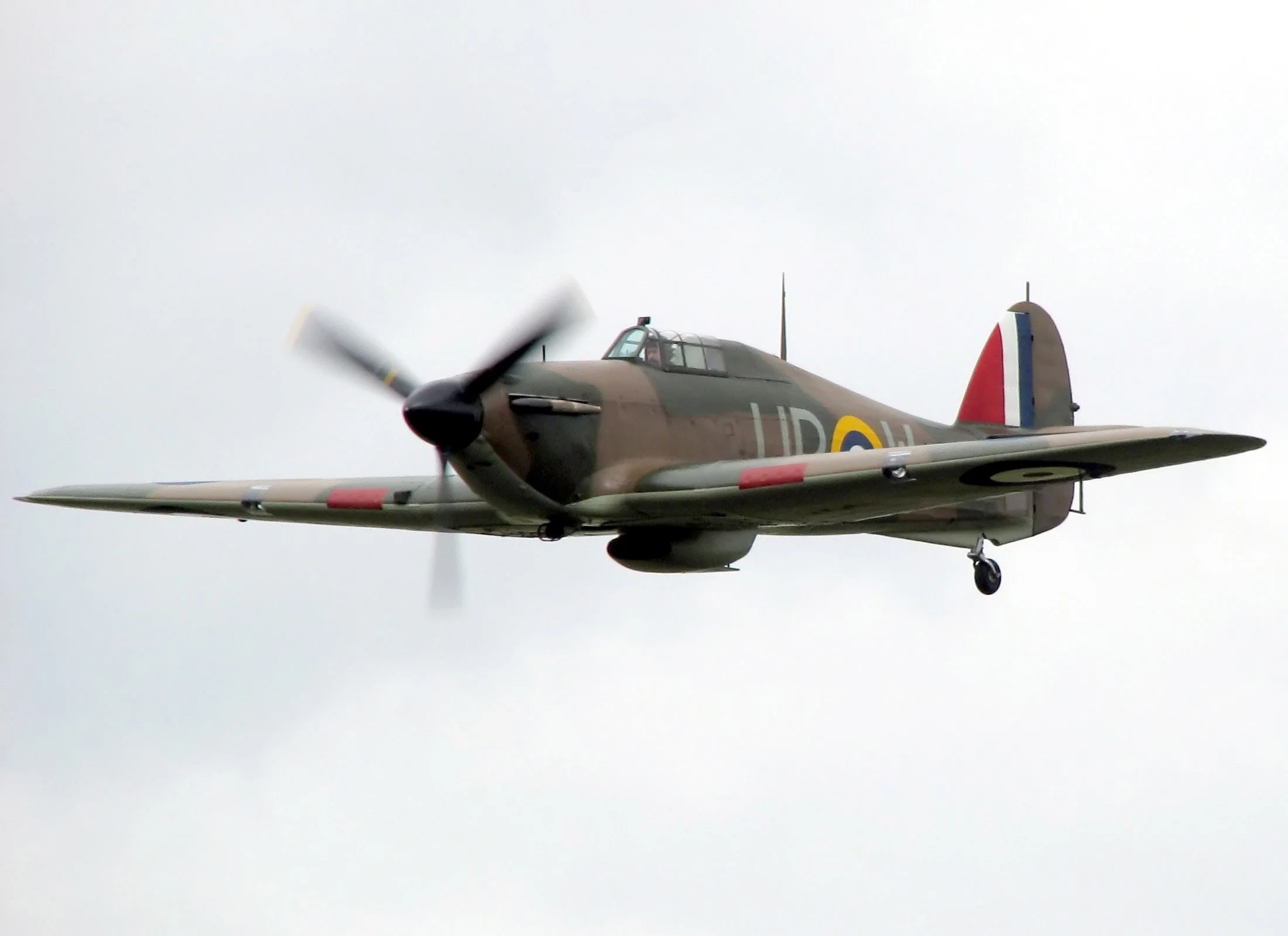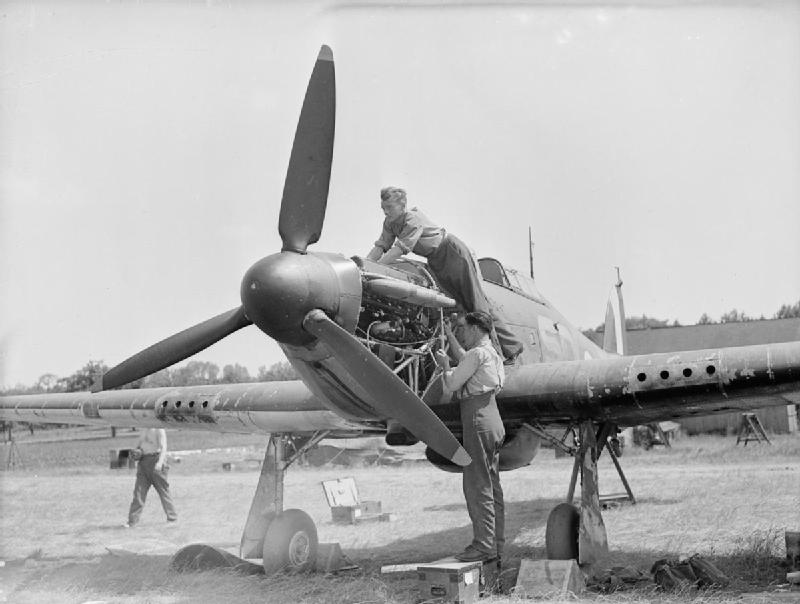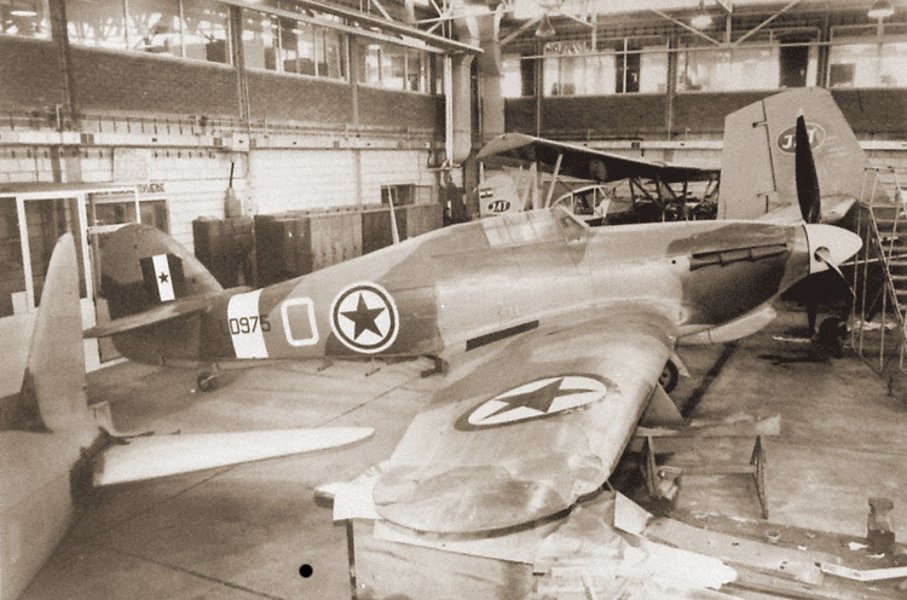
WWII
The Hurricane was the True Hero of the Battle of Britain
The Hawker Hurricane is often overshadowed by the more glamorous Supermarine Spitfire, but it was a critical player in the aerial battles of World War II.
Designed by Sydney Camm and produced by Hawker Aircraft Ltd., the Hurricane earned its place in history through robust design, versatility, and a significant role in the Battle of Britain.
Origins and Development
The origins of the Hawker Hurricane are deeply rooted in the tumultuous interwar period when the Royal Air Force (RAF) sought to modernise its fleet in response to the rapid advancements in aviation technology.
In the early 1930s, the RAF recognised the pressing need for a new generation of monoplane fighters to replace its outdated biplanes. Enter Sydney Camm, a gifted aeronautical engineer working for Hawker Aircraft Ltd., whose innovative approach to aircraft design would soon leave an indelible mark on aviation history.
 The very first Hurricane before its maiden flight in 1935.
The very first Hurricane before its maiden flight in 1935.
Camm began conceptualising the Hurricane in 1933, envisioning a modern fighter aircraft that could deliver superior performance and reliability. Drawing from his extensive experience in designing biplanes like the successful Hawker Fury, Camm opted for a monoplane configuration, which promised greater speed and agility.
He proposed a design that incorporated a fabric-covered metal frame, a choice that balanced the competing demands of structural integrity and ease of repair. This design would later prove advantageous in the heat of battle, where field repairs were often necessary to keep aircraft operational.
By the mid-1930s, the prototype, designated K5083, began taking shape. It featured a cantilever wing structure, retractable undercarriage, and a fully enclosed cockpit, all of which represented significant advancements over the existing RAF biplanes.
The heart of the Hurricane was the Rolls-Royce Merlin engine, a powerful and reliable powerplant that would become synonymous with British aviation excellence during the war.
This engine enabled the Hurricane to reach speeds previously unattainable by RAF fighters, providing a crucial edge in potential aerial combat.
 The famous Merlin engine powered many types of aircraft an even tanks.
The famous Merlin engine powered many types of aircraft an even tanks.
The prototype’s first flight on 6 November 1935 was a momentous event. Piloted by Hawker’s chief test pilot, Flight Lieutenant George Bulman, the Hurricane demonstrated its impressive capabilities right from the start.
It quickly garnered attention for its robust performance and solid handling characteristics, which validated Camm’s design philosophy.
The RAF, recognising the potential of this new fighter, placed an initial order for 600 aircraft in June 1936, signalling the beginning of the Hurricane’s production journey.
The production models of the Hurricane saw several refinements and improvements. Hawker Aircraft streamlined the manufacturing process to expedite the delivery of these crucial fighters to the RAF.
The early production variants, known as the Hurricane Mk I, incorporated changes such as a more powerful version of the Merlin engine and enhancements to the armament.
Initially, the Hurricane was equipped with eight .303-inch Browning machine guns mounted in the wings, which provided formidable firepower against enemy aircraft.
 The first versions of the Hurricane used eight Browning .303 machine guns. Later models had twelve and other variants using four 20mm cannons.
The first versions of the Hurricane used eight Browning .303 machine guns. Later models had twelve and other variants using four 20mm cannons.
Camm and his team continued to innovate, leading to the development of subsequent variants of the Hurricane. Each iteration introduced improvements in performance, armament, and versatility.
The Hurricane Mk II series, for instance, featured a strengthened airframe, more powerful engines, and options for various armament configurations, including cannons and rockets. These advancements ensured that the Hurricane remained a formidable adversary throughout its service life.
The Hurricane’s development also reflected the broader technological and strategic shifts in aviation during the 1930s. As the threat of war loomed, the RAF accelerated its rearmament efforts, and the Hurricane became a central component of this strategy.
Its relatively simple construction made it easier to produce in large numbers, a crucial factor as Britain prepared for the impending conflict.
Role in the Battle of Britain
As the Luftwaffe launched its assault on Britain in the summer of 1940, the Hurricane emerged as a vital defender of the nation’s skies, playing a key role in thwarting the German air offensive.
At the outset of the battle, the Royal Air Force faced the daunting task of repelling a numerically superior and highly experienced enemy. The Luftwaffe, under the command of Hermann Göring, aimed to gain air superiority in preparation for Operation Sea Lion, the planned invasion of Britain.
 A map showing the plan for Operation Sea Lion.
A map showing the plan for Operation Sea Lion.
The German strategy involved extensive bombing raids targeting RAF airfields, radar stations, and industrial centres, aiming to cripple Britain’s defensive capabilities and morale.
The Hurricane, with its sturdy construction and reliable performance, quickly proved to be an invaluable asset in this desperate struggle. RAF Fighter Command, led by Air Chief Marshal Sir Hugh Dowding, employed a strategic approach that maximised the strengths of both the Hurricane and the Supermarine Spitfire.
While the faster and more agile Spitfires engaged the formidable German fighters, the Hurricanes focused on intercepting and destroying the enemy bombers.
This tactical division of labour was instrumental in countering the Luftwaffe’s assault. The Hurricane’s Browning machine guns delivered devastating firepower, making it highly effective against the lumbering bombers.
 A still from camera gun footage of a He-111. These slow bombers were ideal targets for Hurricane pilots.
A still from camera gun footage of a He-111. These slow bombers were ideal targets for Hurricane pilots.
Pilots took advantage of the aircraft’s stability and robust design to press home attacks, often sustaining damage yet remaining airborne. The simplicity of the Hurricane’s construction allowed for rapid repairs, ensuring that damaged aircraft could quickly return to service, maintaining the RAF’s operational strength.
The Hardest Day
“The Hardest Day,” as 18 August 1940 came to be known, was a pivotal moment in the Battle of Britain, highlighting the intense and unrelenting combat that defined the conflict. On this day, the Luftwaffe launched a massive and coordinated assault aimed at crippling the Royal Air Force’s Fighter Command by targeting airfields, radar stations, and aircraft production facilities.
The Hawker Hurricane played a central role in the RAF’s valiant defence, showcasing its resilience and combat effectiveness.
As dawn broke on 18 August, the Luftwaffe initiated their offensive with a series of probing raids to gauge the RAF’s response. The main assault began shortly after midday, with waves of German bombers, escorted by formidable fighter aircraft, converging on key RAF installations across southern England.
The airfields at Kenley, Biggin Hill, and Hornchurch were primary targets, as their destruction would severely hamper the RAF’s operational capabilities.
 A Dornier Do 17 bomber of 9 staffel (Squadron) Kampfgeschwader 76, brought down on 18 August 1940 near RAF Biggin Hill by a Hurricane.
A Dornier Do 17 bomber of 9 staffel (Squadron) Kampfgeschwader 76, brought down on 18 August 1940 near RAF Biggin Hill by a Hurricane.
The Hurricanes, alongside their counterparts, the Supermarine Spitfires, scrambled to intercept the incoming German formations. Pilots of No. 32, No. 111, and No. 242 Squadrons, flying Hurricanes, were among those who took to the skies to defend their airfields and repel the enemy assault.
The Hurricanes, with their robust construction and heavy armament, were well-suited for engaging the slower, heavily laden bombers.
Throughout the day, the skies over southern England became a battleground. Hurricanes engaged in fierce dogfights with the Luftwaffe’s Messerschmitt Bf 109s and Bf 110s while striving to break through the fighter screen to reach the bombers.
RAF Kenley
One of the day’s most intense clashes occurred over RAF Kenley. Hurricanes from No. 32 Squadron, led by Squadron Leader J.A. Leathart, encountered a large formation of Dornier Do 17 bombers, escorted by Bf 109s.
Despite being outnumbered and facing significant fire, the Hurricanes pressed their attacks with determination. They succeeded in downing several bombers, though not without sustaining losses themselves.
 Hawker Hurricane LF636 of the Battle of Britain Memorial Flight. Photo credit – Cpl Phil Major OGL v1.0.
Hawker Hurricane LF636 of the Battle of Britain Memorial Flight. Photo credit – Cpl Phil Major OGL v1.0.
The engagement was brutal, with many Hurricanes returning to base riddled with bullet holes, and several pilots injured or killed in action.
Meanwhile, Hurricanes from No. 111 Squadron were engaged in protecting RAF Biggin Hill. They intercepted a formation of Heinkel He 111 bombers, escorted by Bf 109s.
The Hurricanes dove into the enemy formation, their machine guns blazing. The resulting melee was chaotic and deadly, as the Heinkels attempted to maintain their bombing run while the Bf 109s tried to fend off the attacking Hurricanes.
The relentless assault by the Hurricanes disrupted the bombers, causing several Heinkels to jettison their bombs prematurely and turn back.
Many Lives Were Lost on The Hardest Day
Despite the Hurricane pilots’ bravery and skill, “The Hardest Day” came at a high cost. The Luftwaffe’s relentless assault inflicted significant damage on several airfields, with runways cratered, hangars destroyed, and many aircraft rendered inoperable.
 The Hurricane is often in the shadow of the Spitfire, despite attaining more victories in the Battle of Britain.
The Hurricane is often in the shadow of the Spitfire, despite attaining more victories in the Battle of Britain.
Kenley, Biggin Hill, and Hornchurch were all hit hard, and the RAF’s ground crews worked tirelessly to repair the damage and prepare the remaining Hurricanes for the next day’s battles.
The day’s losses were heavy on both sides, with the RAF losing 68 aircraft and the Luftwaffe 69, a testament to the ferocity of the combat.
The Hurricanes’ role in “The Hardest Day” was emblematic of their broader contribution to the Battle of Britain. The aircraft’s robust design and the determination of its pilots were crucial in absorbing and repelling the Luftwaffe’s onslaught.
Read More: Fieseler F 3 Flying Wing From 1932
Hurricanes were often at the forefront of the defence, engaging enemy bombers and fighters alike with tenacity and skill. Their ability to inflict significant damage on the enemy while sustaining the rigours of intense aerial combat underscored their vital importance to the RAF’s efforts.
The Hurricanes and their pilots had held the line, preventing the Luftwaffe from achieving its objective of incapacitating Fighter Command.
This resilience was a decisive factor in the eventual failure of the Luftwaffe to gain air superiority, marking a turning point in the Battle of Britain and contributing significantly to the eventual Allied victory in the war.

Intense Fighting
The Battle of Britain reached its peak on 15 September 1940, now commemorated as Battle of Britain Day. On this decisive day, the Luftwaffe launched a massive raid, hoping to deal a knockout blow to the RAF.
Hurricanes, along with Spitfires, scrambled to meet the oncoming waves of German bombers and their fighter escorts. The ensuing dogfights over London and the southeast of England were intense and brutal.
Hurricanes accounted for a significant number of the enemy aircraft destroyed, their pilots demonstrating extraordinary bravery and skill in the face of overwhelming odds.
Statistically, Hurricanes were responsible for the majority of the RAF’s victories during the Battle of Britain. Of the 1,963 German aircraft destroyed between July and October 1940, Hurricanes accounted for over half, highlighting their crucial role.
 Easy maintenance was a key factor in the Hurricane’s design.
Easy maintenance was a key factor in the Hurricane’s design.
The aircraft’s ability to absorb damage and continue fighting was a testament to its rugged design and the determination of its pilots.
The contribution of Hurricane Pilots extended beyond just the numbers. Their relentless defence of Britain’s skies provided a critical boost to national morale at a time when the country stood alone against the Axis powers.
The success of the Hurricane in the Battle of Britain symbolised the resilience and ingenuity of the British people, embodying the spirit of defiance that would carry them through the darkest days of the war.
The Hurricane’s role in the Battle of Britain was not confined to daylight operations. As the Luftwaffe shifted its tactics to night bombing raids, known as the Blitz, Hurricanes were adapted for night fighting.
These night fighters were equipped with additional instrumentation and armament to intercept enemy bombers under cover of darkness, further showcasing the aircraft’s versatility.
Versatility in Combat
The Hawker Hurricane’s service during the Second World War extended far beyond its celebrated role in the Battle of Britain. Indeed, the aircraft’s inherent versatility allowed it to adapt to various combat roles across multiple theatres of war, consistently proving its worth in diverse and challenging environments.
For instance, in the North African Campaign, the Hurricane demonstrated its ruggedness and reliability under extreme conditions. The harsh desert climate, with its intense heat and pervasive sand, posed significant challenges for aircraft and crews alike.
Nevertheless, the Hurricane adapted well to these adversities. Its air-cooled engine was less susceptible to overheating, and the relatively simple construction made it easier to maintain in the field. As a result, Hurricanes were primarily employed in ground-attack roles, strafing enemy positions and providing close air support to the British Eighth Army.
Furthermore, they also carried out reconnaissance missions and escorted bombers, showcasing their multifaceted capabilities.
 Depending on the variant, the Hurricane had either 4, 8 or 12 .303 machine guns.
Depending on the variant, the Hurricane had either 4, 8 or 12 .303 machine guns.
Additionally, the Hurricane’s adaptability shone through in its ability to operate from makeshift airstrips. In North Africa, where infrastructure was often minimal, the aircraft’s robust undercarriage and forgiving handling characteristics allowed it to take off and land on rough, unprepared surfaces.
Therefore, this operational flexibility was a significant advantage, enabling the RAF to maintain a forward presence and respond swiftly to changing tactical situations.
Mediterranean Service
In the Mediterranean theatre, the Hurricane continued to prove its versatility. Notably, Hurricanes launched from aircraft carriers provided crucial air cover during the critical supply convoys to Malta, a strategic island fortress under constant siege by Axis forces.
Read More: Junkers Ju 390 New York Blitz Bomber
These sea-borne Hurricanes, adapted for naval operations, further demonstrated their effectiveness in maritime environments by engaging enemy aircraft and protecting vital supply lines. Consequently, their role in the defence of Malta was pivotal, helping to ensure the island remained a key Allied base throughout the war.
Furthermore, the Hurricane’s operational range extended to the Far East, where it faced the Japanese in the jungles of Burma and the skies over India. In this region, the aircraft encountered a different set of challenges, including tropical climates and a well-equipped enemy air force.
 The four 20mm Hispano cannons were deadly. They had many different applications during the war.
The four 20mm Hispano cannons were deadly. They had many different applications during the war.
Despite these difficulties, the Hurricane adapted once more, proving its reliability and combat effectiveness. In the dense jungles, it conducted ground-attack missions against Japanese forces, thereby disrupting supply lines and supporting Allied ground operations.
Additionally, the Hurricane’s ability to carry a variety of ordnance, including bombs and rockets, made it a formidable opponent in these missions.
The adaptability of the Hurricane was further exemplified by its numerous variants, each tailored to specific combat needs. For instance, the Hurricane Mk IIC, equipped with four 20 mm Hispano cannons, provided increased firepower for engaging armoured targets and enemy aircraft.
Meanwhile, the Mk IV variant, fitted with underwing rockets, excelled in the ground attack role, delivering devastating strikes against enemy armour and fortifications. These modifications underscored the aircraft’s capacity to evolve and meet the demands of different combat scenarios.
Moreover, the Hurricane also served in a night-fighter role, particularly during the Blitz when the Luftwaffe shifted to nocturnal bombing raids.
Equipped with radar and additional instrumentation, these night-fighter Hurricanes intercepted enemy bombers under the cover of darkness, thus adding another dimension to the aircraft’s combat versatility.
 A Hurricane MK.IV flown by Yugoslavia. Photo credit – muzejvazduhoplovstva.org.rs CC BY 3.0.
A Hurricane MK.IV flown by Yugoslavia. Photo credit – muzejvazduhoplovstva.org.rs CC BY 3.0.
The aircraft’s global service record is a testament to its adaptability and enduring value. From the frozen tundras of Russia, where Hurricanes supplied to the Soviet Union under Lend-Lease engaged German aircraft, to the tropical climates of Southeast Asia, the Hurricane proved itself a reliable and effective combat platform.
Read More: The BV 142 Was Built by Shipbuilders
Ultimately, its deployment in varied theatres underscored its status as a workhorse of the Allied air forces.
News
The Hanging Temple: China’s 1,500-Year-Old Cliffside Marvel of Faith and Engineering
The Hanging Temple: China’s 1,500-Year-Old Cliffside Marvel of Faith and Engineering Perched precariously on the cliffs of Mount Heng in Shanxi Province, China, the Hanging Temple, also known as Xuankong Temple, Hengshan Hanging Temple, or Hanging Monastery, is an architectural…
The Willendorf Venus: A 30,000-Year-Old Masterpiece Reveals Astonishing Secrets
The Willendorf Venus: A 30,000-Year-Old Masterpiece Reveals Astonishing Secrets The “Willendorf Venus” stands as one of the most revered archaeological treasures from the Upper Paleolithic era. Discovered in 1908 by scientist Johann Veran near Willendorf, Austria, this small yet profound…
Unveiling the Maya: Hallucinogens and Rituals Beneath the Yucatán Ball Courts
Unveiling the Maya: Hallucinogens and Rituals Beneath the Yucatán Ball Courts New archaeological research has uncovered intriguing insights into the ritual practices of the ancient Maya civilization. The focus of this study is a ceremonial offering found beneath the sediment…
Uncovering the Oldest Agricultural Machine: The Threshing Sledge’s Neolithic Origins
Uncovering the Oldest Agricultural Machine: The Threshing Sledge’s Neolithic Origins The history of agricultural innovation is a fascinating journey that spans thousands of years, and one of the earliest known agricultural machines is the threshing sledge. Recently, a groundbreaking study…
Nara’s Ancient Sword: A 1,600-Year-Old Protector Against Evil Spirits
Nara’s Ancient Sword: A 1,600-Year-Old Protector Against Evil Spirits In a remarkable discovery that has captured the attention of archaeologists and historians alike, a 7.5-foot-long iron sword was unearthed from a 1,600-year-old burial mound in Nara, Japan. This oversized weapon,…
The Inflatable Plane, Dropped Behind the Lines for Downed Pilots
Experimental The Inflatable Plane, Dropped Behind the Lines for Downed Pilots The Inflatoplane from Goodyear was an unconventional aircraft developed by the Goodyear Aircraft Company, a branch of the renowned Goodyear Tire and Rubber Company, also famed for the Goodyear…
End of content
No more pages to load












